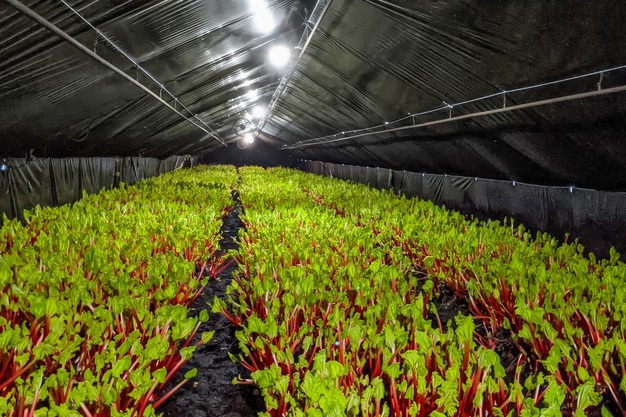Consumers can now rejoice as the first harbingers of spring are making an appearance in the fruit and vegetable aisle: In week 7, Landgard member companies in the West began harvesting the season's first regional fresh rhubarb. Currently available in limited quantities, these tender stalks grow in halls or greenhouses at a constant temperature of 15 degrees. The harvest season for outdoor rhubarb in the Lower Rhine region and around Cologne then starts, depending on the weather, roughly from the end of March/beginning of April.
"The exact course of the season is primarily determined by sunlight," explains Fabio Winzen. Along with his father, the 26-year-old manages the family business in Brüggen, where he is primarily responsible for vegetable production. "Traditionally, the demand for rhubarb is especially high in the week before Easter. However, with the holiday falling in late March this year, it will be interesting to see if enough outdoor produce will be available on the market in time."

The Winzen family cultivates rhubarb on a total of 27 hectares in the Lower Rhine region, using heated greenhouses, foil tunnels, and open ground. "Our rhubarb plants have come through the winter well. Despite the relatively mild weather, the plants have achieved the necessary cold sum. And, unlike some other operations, we were fortunate not to have any problems with waterlogging. Overall, we are confident and looking forward to a good rhubarb season," says the farm manager.
Strong demand in the fresh market as well as in the industry
Key to this, of course, is not only good product quality but also a reasonable price for the goods. Rhubarb is among the labor-intensive crops, hence expensive to cultivate, as harvesting is done exclusively by hand. Fabio Winzen: "Yet, the demand in the trade is strong, and the industry, after a decline during the Corona period, now has an increased demand for rhubarb for juice production again."
Landgard member companies in the west of Germany cultivate rhubarb on an area of about 200 hectares. The focus of production is in the foothills of the Cologne-Bonn Bay. There, the perennial plants find optimal growing conditions. In May and June, fresh rhubarb from regional cultivation will also be harvested in the east of Germany. The rhubarb season traditionally ends on St. John's Day, June 24th.
Images: ©Fabio Winzen / Landgard eG
For more information:
www.landgard.de
